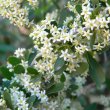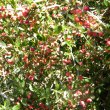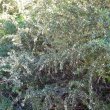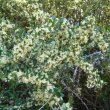| Botanical Name |
Gymnosporia polyacantha subsp. polyacantha |
| Family |
Celastraceae - The Spike-thorn family. |
| Pronunciation |
jim-no-SPOR-ee-uh pol-lee-uh-KAN-tha |
| Common Name(s) |
English: Hedge spikethorn; Kraal spikethorn
Afrikaans: Kraalpendoring
|
| Plant Group |
- Tree A woody, self-supporting perennial plant usually with a single main stem and generally growing more than 6 meters tall.
|
| Plant Size |
- Very Small
| Tree | 3m to 4m |
| Shrub | 25cm to 50cm |
| Perennial/ground cover | Up to 10cm |
| Bulb | 10cm to 20cm |
| Succulent | Up to 5cm |
|
| Position |
- Partial Shade The area is in shade for part of the day and in full sun for part of the day.
- Sun The area is in full sun for all or most of the day, all year round.
|
| General Information |
- Attractive fruits, berries or seeds Brightly coloured fruits or berries increase and extend the visual impact of the plant and are especially attractive to birds and other small wildlife.
- Drought Tolerance: High The plant is well adapted to arid conditions; it can survive long periods of drought and high temperatures without extra water.
- Evergreen Plants that have leaves all year round.
- Frost: Hardy The plant can withstand freezing temperatures or frost without artificial protection.
- Thorns / Spines / Prickles Thorn: A hard, woody, pointed branchlet.
Spine: A modified leaf forming a hard, sharp-pointed outgrowth.
Prickle: A small, sharp-pointed outgrowth growing from the bark of the plant.
- Water Wise Plant species originating from low rainfall regions that require less water to survive and thrive than other plant species.
- Wind Tolerant Plants able to withstand the effect of strong winds.
|
| Specific Information |
Gymnosporia polyacantha subsp. polyacantha is a multi-stemmed shrub or small tree with branches that curve down giving a weeping effect. Usually about 1.5 m tall, it can reach up to 4 m. The branches are armed with strong, stout spines up to 70 mm long. The small, leathery, rather narrow leaves may be dark or yellowish green and are clustered on small side branches. The fruit is a reddish-brown capsule with three chambers and the seeds are partially covered with a yellow aril. The fruit and flowers attract birds and insects. This species is especially useful for use as a barrier or hedge, the thorns making it virtually impossible to penetrate. It also provides suitable nesting sites for various bird species.
|
| Ad Break |
|
| Flowers |
| Description |
masses of small star-shaped flowers in the leaf axils on stalks about 2 cm long
|
| Season |
- Autumn to Winter Plants will seldom bloom for the entire season as given in the list, but should flower during a period within these parameters.
|
| Colour |
|
| Growth Rate |
- Moderate Specifying growth rate can be very misleading as there is considerable variation of growth rate depending on type and species of plant, available water, supplementary feeding, mulching and general care, as well as the plants suitability and adaptability to the garden environment.
|
| Plant Uses |
- Attracts bees, butterflies or other insects This plant attracts insects which can be food for birds or other creatures in your garden.
- Attracts Birds This plant will attract birds.
- Barrier Plant A very thorny shrub, tree or scrambler that can be used to create an impenetrable barrier.
- Boundary A plant useful for planting around the edges of the property to form a green or colourful backdrop, an impenetrable hedge, to hide walls or create privacy.
- Hedge Suitable trees or shrubs planted relatively close together so that the branches intertwine to create a barrier. This can be formal – the plants are regularly trimmed to produce a neat shape, or informal – the plants are left to themselves to create a natural hedgerow.
- Suitable for coastal gardens Plants adapted to dry, sandy soil, forceful wind, limited rainfall and intense sunlight.
- Wild Garden An indigenous garden planted for the benefit of wildlife and birds. Provides food, water, a variety of mini-biomes and no poisonous chemicals are used.
|
| Distribution and Habitat |
Eastern Cape from Port Elizabeth to East London and inland to Fort Beaufort, in dry, mixed woodland
|
| Planting Suggestions |
Gymnosporia polyacantha needs well drained soil and will tolerate stony, arid and nutrient poor soils. For faster growth add some compost and a little bone meal to the hole and mix well before planting. Water deeply every week or two until established and new growth is evident. Watering can then be reduced if desired until the plant is completely water wise.
The old method of digging a deep hole and filling it with soil and compost has resulted in many trees failing to thrive, dying, rotting at the base or worse still, falling over in later years due to poor root development. Refer to the following sites for the best method of planting trees:
Treehelp.com: Planting a tree
International Society of Arboriculture: New Tree Planting
Tree People: Plant the right way
For those of you who have a clay problem try:
Rod's Garden: Planting in clay soil
|
| Medicinal Uses |
|
| Ad Break |
|











Discuss this plant
Share knowledge, ask a question or give an experience.